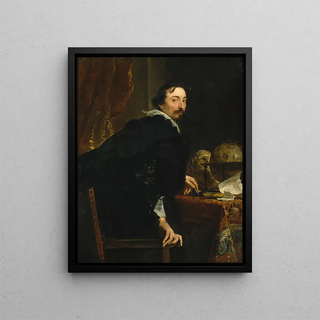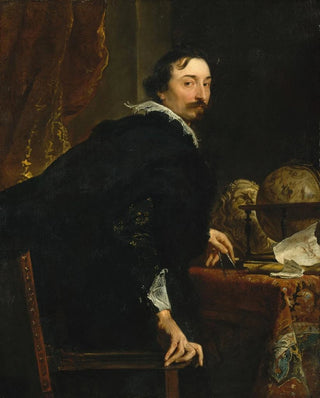Art print | Lucas van Uffel died in 1637 - Antoine van Dyck


View from behind

Frame (optional)
Lucas van Uffel Art print by Antoine van Dyck – Engaging Introduction
The artwork "Lucas van Uffel died in 1637" by Antoine van Dyck is much more than a simple depiction of a historical figure; it is a vibrant testament to Baroque art, an era where light and shadow danced across the canvas to evoke palpable emotions. This painting, created by one of the masters of portraiture, not only captures the personality of the subject but also reflects the political and social atmosphere of his time. Gazing upon this piece, the viewer is transported into a world where art and life intertwine, where each brushstroke tells a unique story. The psychological depth of the subject, enhanced by van Dyck's technical mastery, invites reflection on mortality and legacy.
Style and uniqueness of the work
Van Dyck's style is distinguished by its elegance and ability to capture the very essence of his models. In "Lucas van Uffel died in 1637," the artist employs a rich palette and striking contrasts to bring his subject to life. The way light illuminates Lucas van Uffel's face, while leaving mysterious shadowed areas, reveals a profound understanding of human emotions. The sumptuous drapery, typical of Baroque style, adds a tactile dimension to the painting, while the subject's posture suggests both dignity and vulnerability. Every detail, from color choices to composition, is carefully considered to evoke an atmosphere of gravity and respect, transforming the work into a true homage to the memory of the man depicted.
The artist and his influence
Antoine van Dyck, a pupil of Rubens, established himself as one of the most influential portraitists of his time. His style, marked by great finesse and particular sensitivity, profoundly impacted art history. By focusing on the psychology of his subjects, van Dyck pioneered a new way of conceiving portraiture, where individuality and personality take precedence over mere physical representation. His influence extends far beyond his era, inspiring generations of artists who sought to capture not only the

Matte finish

View from behind

Frame (optional)
Lucas van Uffel Art print by Antoine van Dyck – Engaging Introduction
The artwork "Lucas van Uffel died in 1637" by Antoine van Dyck is much more than a simple depiction of a historical figure; it is a vibrant testament to Baroque art, an era where light and shadow danced across the canvas to evoke palpable emotions. This painting, created by one of the masters of portraiture, not only captures the personality of the subject but also reflects the political and social atmosphere of his time. Gazing upon this piece, the viewer is transported into a world where art and life intertwine, where each brushstroke tells a unique story. The psychological depth of the subject, enhanced by van Dyck's technical mastery, invites reflection on mortality and legacy.
Style and uniqueness of the work
Van Dyck's style is distinguished by its elegance and ability to capture the very essence of his models. In "Lucas van Uffel died in 1637," the artist employs a rich palette and striking contrasts to bring his subject to life. The way light illuminates Lucas van Uffel's face, while leaving mysterious shadowed areas, reveals a profound understanding of human emotions. The sumptuous drapery, typical of Baroque style, adds a tactile dimension to the painting, while the subject's posture suggests both dignity and vulnerability. Every detail, from color choices to composition, is carefully considered to evoke an atmosphere of gravity and respect, transforming the work into a true homage to the memory of the man depicted.
The artist and his influence
Antoine van Dyck, a pupil of Rubens, established himself as one of the most influential portraitists of his time. His style, marked by great finesse and particular sensitivity, profoundly impacted art history. By focusing on the psychology of his subjects, van Dyck pioneered a new way of conceiving portraiture, where individuality and personality take precedence over mere physical representation. His influence extends far beyond his era, inspiring generations of artists who sought to capture not only the






